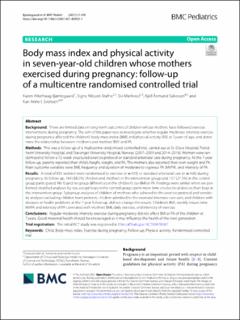| dc.contributor.author | Bjøntegaard, Karen Alterhaug | |
| dc.contributor.author | Stafne, Signe Nilssen | |
| dc.contributor.author | Mørkved, Siv | |
| dc.contributor.author | Salvesen, Kjell Å | |
| dc.contributor.author | Evensen, Kari Anne Indredavik | |
| dc.date.accessioned | 2022-04-04T13:18:06Z | |
| dc.date.available | 2022-04-04T13:18:06Z | |
| dc.date.created | 2021-11-22T21:12:06Z | |
| dc.date.issued | 2021 | |
| dc.identifier.citation | BMC Pediatrics. 2021, 21 (1), 1-11. | en_US |
| dc.identifier.issn | 1471-2431 | |
| dc.identifier.uri | https://hdl.handle.net/11250/2989690 | |
| dc.description.abstract | Background
There are limited data on long-term outcomes of children whose mothers have followed exercise interventions during pregnancy. The aim of this paper was to investigate whether regular moderate intensity exercise during pregnancy affected the children’s body mass index (BMI) and physical activity (PA) at 7 years of age, and determine the relationship between children’s and mothers’ BMI and PA.
Methods
This was a follow-up of a multicentre randomised controlled trial, carried out at St. Olavs Hospital, Trondheim University Hospital, and Stavanger University Hospital, Norway (2007–2009 and 2014–2016). Women were randomised to follow a 12-week structured exercise protocol or standard antenatal care during pregnancy. At the 7-year follow-up, parents reported their child’s height, weight, and PA. The mothers also reported their own weight and PA. Main outcome variables were BMI, frequency and duration of moderate to vigorous PA (MVPA), and intensity of PA.
Results
A total of 855 women were randomised to exercise (n = 429) or standard antenatal care (n = 426) during pregnancy. At follow-up, 164 (38.2%) children and mothers in the intervention group and 117 (27.5%) in the control group participated. We found no group differences in the children’s iso-BMI or PA. Findings were similar when we performed stratified analyses by sex, except boys in the control group spent more time on electrical devices than boys in the intervention group. Subgroup analyses of children of mothers who adhered to the exercise protocol and sensitivity analyses excluding children born preterm, children admitted to the neonatal intensive care unit, and children with diseases or health problems at the 7-year follow-up, did not change the results. Children’s BMI, weekly leisure time MVPA and intensity of PA correlated with mothers’ BMI, daily exercise, and intensity of exercise.
Conclusions
Regular moderate intensity exercise during pregnancy did not affect BMI or PA of the children at 7 years. Good maternal health should be encouraged as it may influence the health of the next generation. | en_US |
| dc.language.iso | eng | en_US |
| dc.publisher | BMC | en_US |
| dc.rights | Navngivelse 4.0 Internasjonal | * |
| dc.rights.uri | http://creativecommons.org/licenses/by/4.0/deed.no | * |
| dc.subject | Body mass index | en_US |
| dc.subject | Pregnancy | en_US |
| dc.subject | Exercises | en_US |
| dc.subject | Physical activity | en_US |
| dc.subject | Follow-up | en_US |
| dc.title | Body mass index and physical activity in seven-year-old children whose mothers exercised during pregnancy: Follow-up of a multicentre randomised controlled trial | en_US |
| dc.type | Peer reviewed | en_US |
| dc.type | Journal article | en_US |
| dc.description.version | publishedVersion | en_US |
| cristin.ispublished | true | |
| cristin.fulltext | original | |
| cristin.qualitycode | 1 | |
| dc.identifier.doi | 10.1186/s12887-021-02952-1 | |
| dc.identifier.cristin | 1957486 | |
| dc.source.journal | BMC Pediatrics | en_US |
| dc.source.volume | 21 | en_US |
| dc.source.issue | 1 | en_US |
| dc.source.pagenumber | 1-11 | en_US |

